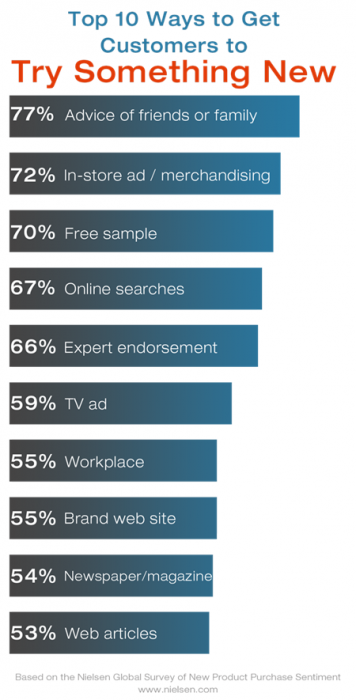Personal Referrals Most Persuasive Driver of Brand Awareness
Personal referrals are the most persuasive driver of brand awareness, but not the only one. Find out what else made the list of Top 10 Brand Awareness Drivers.
Top 10 Drivers of Brand Awareness
Do you want to attract new customers or get your customers to try something new? New data from Nielsen identifies key marketing strategies to consider when launching a new company or introducing new products or services to consumers.
It’s hard enough to build a client base and gain market share when members of your target markets are already aware of the types of products or services you sell, or are already familiar with your brand, and so are willing to try something new. Businesses that are new to the market or who are trying to introduce something new to the market face even tougher challenges.
From identifying and effectively reaching new target markets and niche audience groups to persuading those prospects to take a chance on something new, retail and service businesses will need a multi-channel marketing strategy in order to deploy the marketing tactics most likely to work.
New data from Nielsen points to the most effective ways to drive brand and new product adoption among consumers. Here are the top 10 drivers for awareness when it comes to new products, services or brands from the Nielsen survey*:

77% – Advice of Family and Friends
Perhaps not surprising, consumers are most likely to try something new when it comes with the endorsement of family or friends. Is your marketing strategy designed to motivate personal recommendations? For instance, you could:
- Follow up with an electronic survey to get feedback about customers experience and provide easy social media and forward to a friend sharing options
- Incentivize referrals of family or friends to your business or incentivize referral sales of new services or products specifically
- Interact with your most engaged customers on social media to stimulate discussion about your brand or new products or services
- Hold prize drawings where contestants entry is based on social shares of your brand’s social media profile page, ad post or status update
72% – In-Store Advertising
Today’s sophisticated e-commerce sites are programmed to show you ads with similar items or other items purchased by consumers who purchased the same item(s) you did. Make sure that your in-store advertising is intuitive in the same ways:
- Displays showing accessories, add-on or upgrade options alongside an item
- Displays that speak to common needs and wants of consumers
- Impulse and high-traffic ads and displays to bring customers’ attention to new products or services
- Staff scripts on the selling floor and at the point of sale
70% – Free Sample
Tried and true, sampling has been the precursor to new product adoption for thousands of years. Try offering a free sample, creating a mini-version of a new service or promote new product adoption by giving away a trial version of a product or service as a free gift-with-purchase during an introductory period.
67% – Online Search
Nowadays, it’s difficult to find a purchase made anywhere that did not start online, in one way or another. Online content that is optimized for search and engaging to real people is one of the best ways to attract the attention of consumers and build brand and product awareness.
66% – Professional Expert Recommendation
A close cousin to referrals from friends or family, recommendations from professionals are highly influential when it comes to building awareness of a new product, service or brand.
- Infuse your web and social network content with quotes from experts in or outside of your company
- Extend an invitation to local celebrities, dignitaries, experts or other business owners to try your business or new products or services at no cost – beyond their public endorsement (provided they had a satisfactory experience)
59% – TV Ads
While today’s consumer is savvy and may be more inclined to view paid advertising with skepticism, mass media advertising still holds sway and provides a way to get your brand message, product or service in front of a larger number of prospective customers than other marketing channels.
55% – Recommendation from Someone at Work
For B2B brands or a business whose target markets share traits such as common industries or professions, targeting individuals within those types of jobs with marketing or incentives for referrals may also be an effective way to increase brand awareness or introduce new products or services.
55% – Brand Website
It stands to reason that – since most consumers research products and services online before making a purchase or even contacting a salesperson – a brand’s website can be influential in persuading consumers to try a new store, product or service.
54% – Newspaper or Magazine Ad
Paid advertising is still an effective way of reaching consumers and increasing brand awareness. Marketers considering this (or any other paid advertising) should have a strong understanding of their target markets and place paid ads in those publications that reach concentrations of their ideal customer types.
53% – Website Articles
Presumably, website articles would include blogs, micro-blogs and other content farms where smart marketers take the opportunity to publish content that is optimized for search and speaks to the common needs and wants of their target audiences. If you can get the attention of consumers online, you have a great opportunity to introduce them to your brand or increase awareness of new products or services you offer.





